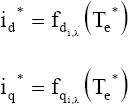THE INDIRECT VECTOR CURRENT CONTROL
Boldea I., Nasar S.A.
Source of information: "Vector control of a.c. drives", Chapter 10, CRC Press, Florida, USA, 1992.
Indirect vector current control means, in fact, making use of precalculated
![]() , to produce the reference d-q currents
, to produce the reference d-q currents
![]() . Then, with Park transformation, the reference
phase current controllers are used to produce PWM in the inverter. A rotor position sensor is required for position and speed feedback (11.25).
. Then, with Park transformation, the reference
phase current controllers are used to produce PWM in the inverter. A rotor position sensor is required for position and speed feedback (11.25).

Figure 11.25. Indirect vector current control of PM-SM
As for the IMs, the a.c. controllers may be replaced by d.c. current controllers (in rotor coordinates) to improve the performance at high speeds especially. Though, in principle,
direct vector control is possible, it is hardly practical unless the drive is sensorless.
Note that the flux limit is related to speed wr. So, in fact, the torque Te* is limited with respect to stator current and flux (speed) (Figure 11.23a).
Te* limit is dependent on speed (Figure 11.24b).
Figure 11.24. id-iq optimum relationship and torque and flux limits with speed
